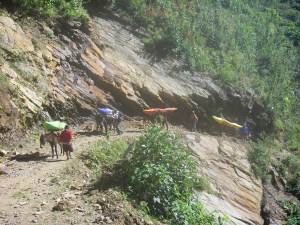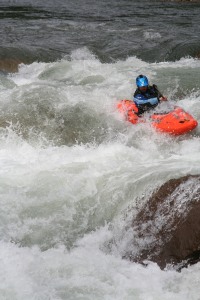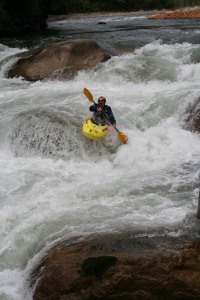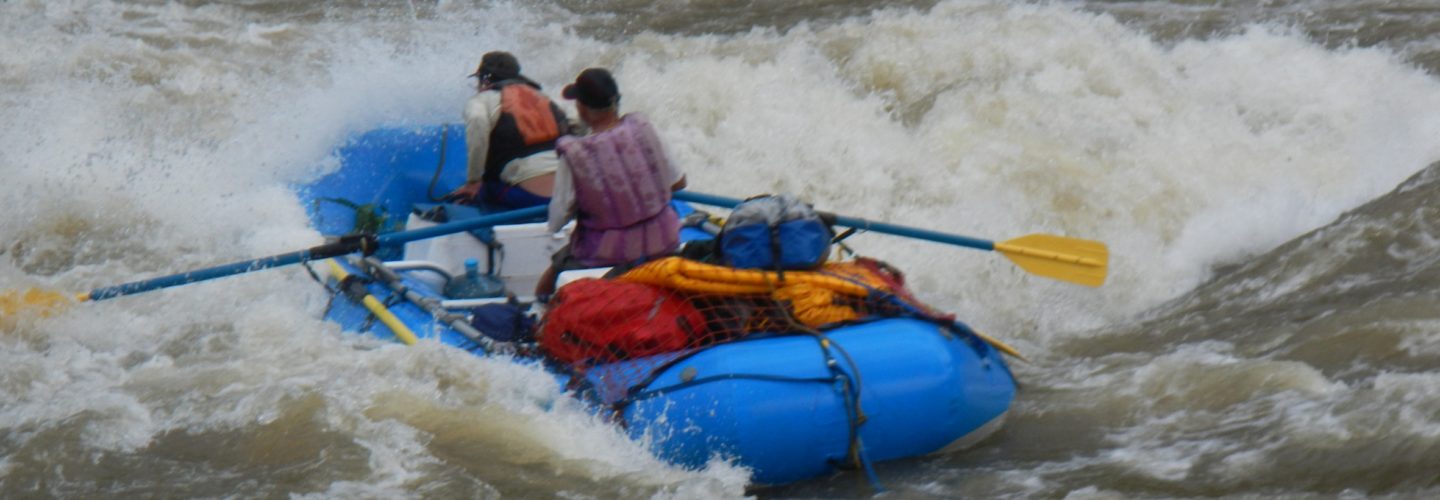Reprinted from article “Below and Beyond Machu Picchu 2009”
Wow, these days its very rare to find a new river. However when you find a new river how often is it sheer WORLD CLASS. Yesterday we arrived back in Cusco, after completing the first descent of the Rio Concebidayoc in the Quillabamba region.
As we had hoped the river was as perfect levels and with plenty of hardwork and careful planning from Paul Cripps of Amazonas Explorer we set off into the jungle last friday. On the way we safety kayaked the Urubamba from Santa Teresa to Santa Maria (big water class 5 in yet another deep inescapable gorge, something that became the norm for the trip). As part of a recce trip for Amazonas Explorer, so if you fancy a one day HARD rafting trip contact them.
 Rafting and Safety kayaking the Santa Teresa section
Rafting and Safety kayaking the Santa Teresa sectionThe journey continued late into the night arriving 6 hours later at Keteni. Keteni is the nearest town to the end of the river, where the Concebidayoc joins the Urubamba and heads into the jungle towards the Amazon and Brasil.
After a quick look at the take out in the dark we declared the river suitable to run and proceeeded up the dirt road to the road head at Azul Mayo. With a few glimpses of the river below we prepared and loaded the mules for the trek further up river towards Espiritus Pampa and the hamlet of Concebidayoc.
The trek up river was knocked off slightly faster than most groups with us arriving at Espiritus Pampa by lunchtime. Espiritus Pampa is a very special place. Known as the last settlement of the Inca regime, not Machu Picchu as originally beleived by Hiram Bingham. The ruins are still being discovered and explored since Vincent Lee and Gene Savoy declared the site as the Incas final resting place.
This is where Paul discovered the river last year whilst running one of his treks to the area, so it was amazing to see only two hundred visitors had been to the ruins since Pauls last visit. Since 2002 Espiritus Pampa has only seen 1200 visitors, thats equivalent to what Machu Picchu receives in a day.
 Mules trekking in
Mules trekking inThe next stage of the the journey saw us retrace some of the Inca footsteps over some amazing steps and paths to where we found our home for a night, an old school hall. Early the following morning we continued our journey upstream to a put in with a cable over the river, approximately 50 kilometres upstream from our get out point in Keteni. The put in was idyllic, with torquoise water, gentle grade 3 rapids and the sun beating down on us in the canyon floor.
After the ‘faff’ of packing and loading our kayaks with food and provisions for four days we set off downstream just before lunch on Saturday.
We were instantly in heaven, flowing moves, catching eddies and paddling the finest whitewater ever. We paddled about 750m of this until we encountered our first steep section. River wide boulder garden we opted to bank inspect before running a nice set of lines. We continued with similar water, becoming consistently harder as we moved downstream.
The rapids continued to steepen, with must make moves and lines as trees and siphons started to appear with regular occurrence. Moving slowly as inspections were nearly always mandatory we inched down the canyon.
 Adam flairing into an eddy to avoid the toaster slot below
Adam flairing into an eddy to avoid the toaster slot belowWith sunlight leaving and the canyon walls closing in we came across our first portage, technical with steep walls and slippery rocks we entered into our first set of must run rapids.
Shortly after tension started to grow as again we faced further portages and steepening walls. A small hamlet was spotted high on the right bank, just above a blind class 5-6 rapid. It was time to camp.
That evening discussion soon turned to who would run the rapid at first light and whether if entering, escape would be impossible. Lengthy debate was had and we all agreed a remote, dense jungle gorge was not the environment to lose a close friend in a wreckless decision.
Further inspection was needed although almost impossible we elected to portage with the idea of the ever increasing canyon walls encasing us within an un-runnable fall and without outside help being able to assist.
The job to portage was no small effort. Paul speaking spanish set off with bare essentials 5 km back upstream where we started the day before, meanwhile Pete, Spike and I hauled the boats from the canyon up towards the path whilst cutting through deep undergrowth. This was the start of a potential epic and major portage through the jungle.
 Pete and Adam hauling the kayaks
Pete and Adam hauling the kayaksMonday saw us return to the river in a much more suitable place with flowing rapids, continuous class 4 interspersed with the occasional class 5. Our pace quickened as we were able to again read and run most of the rapids. The walls did close in for a short while as we came close to Azul Mayo (the roadhead), giving us this amazing canyon feel in a friendlier setting, with help and access not to far away if we needed it. One of the rapids we named as ‘Fairy Glen South’, so similar to the Welsh classic with warm water and the sun beating down on us once again.
 Paul hucking the boof
Paul hucking the boofAs the rapids began to ease we started to search out a campsite, looking for flat sand, trees to hang hammocks from and plenty of firewood, enabling us to cook up a feast and dry our wet kit after what had been the best day of remote kayaking ever.
 Pete focused on his line
Pete focused on his lineTuesday was now the final day and with gravel bed rapids becoming the norm progress was moving fast and we were eating the remaining 27 km easily until one slightly bigger rapid hit us hard, on the limit of read and run we got a real shake up and we finished in the pool smiling and giggling at an awesome class 4+ drop.Our mood again relaxed and we continued around the corner. Bad idea, we encountered a huge double tiered drop, easily class 5. Running the entry fall was ok but we opted for a slight chicken line to finish, looking towards a house eating pourover we were happy with our decision.
 Spike on the final hard rapid
Spike on the final hard rapid The Team (L-R) Jon ‘Spike’ Green, Pete Catterall, Paul Cripps and Adam Harmer
The Team (L-R) Jon ‘Spike’ Green, Pete Catterall, Paul Cripps and Adam Harmer